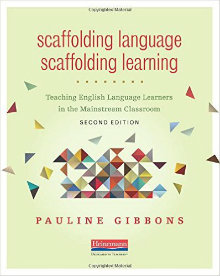Teaching EL Learners in Mainstream Classrooms
Scaffolding Language, Scaffolding Learning : Teaching English Language Learners in the Mainstream Classroom
By Pauline Gibbons
(Heinemann, 2015 – Learn more)

In these times, every teacher is a teacher of academic language development. Since EL learners have joined regular classrooms, teachers are responsible to instruct in subject matter and scaffold language development as needed.
In her book Scaffolding Language, Scaffolding Learning, Pauline Gibbons describes the contexts of culture and situation that determine how language varies. Academic language requires more explicit meanings than informal conversations. Meaningful language learning occurs when language is used in context.

Examining four essential areas of learning
Aiming to stimulate teachers to develop integrated curriculum for ELLs, Gibbons discusses ELL issues in each of the four essential areas of speaking, listening, reading and writing in separate chapters, weaving implications from relevant research about second language learning throughout.
Chapter 2 focuses on TALK – a fundamental activity in every classroom – and how teachers can use dialogic teaching to co-construct curriculum, interacting with their students and deepening their comprehension.
When information is given in complementary ways, with timely spaced words and phrases, demonstrations, color coding, and contrasting sentences, learners have more opportunities to access it. In the context of partner and group collaboration, the author illustrates using the information gap principle with examples of tasks designed to require SPEAKING for completion. Through progressive brainstorming, paired problem solving, and related techniques, children participate in authentic contexts, hearing language for reporting, questioning, justifying, and adding information.
Eavesdropping on second graders in science class, we hear students doing experiments in small groups, preparing to present their results to classmates. Gibbons notes how the teacher “leads from behind,” asking questions to encourage generalizations, giving students more time to think, recasting student responses, modeling alternative forms of appropriate language that facilitates writing in the last stage. Explicitly teaching vocabulary, she modifies her sentences to include literate talk, which can serve as a “bridge” to more formal wording that is appropriate for writing later.
Both spoken and written genres are used purposefully in a culture, and students must learn the most appropriate language as well as the most appropriate ways to get things done. Charting characteristics of genres, Gibbons prescribes the four stages of the teaching and learning cycle: building knowledge of the topic, modeling the genre, collaborating in constructing with explicit focus on the process, and independent writing. These are essential tools for creativity.
Bridges to READING are built on more than phonemic awareness—what each reader brings to the text in his head contributes to comprehension. After describing four roles effective readers must take, Gibbons directs teachers to plan before-, during-, and after-reading activities, describing many.
LISTENING is the “Cinderella” of language, often forgotten or taken for granted. Parallel to the process of reading, it requires the listener to actively construct meaning, and discriminate between differences. More than just the sounds of words, what the listener expects or predicts, what connects with his in-the-head knowledge, and what he knows about the structure of language help him tune in effectively.
It was helpful to see quadrants describing four different contexts for listening. The remainder of the chapter is filled with activities that require the listener to take action, enabling the observer to see if effective listening has occurred. “Dictogloss” integrates listening with speaking, reading, writing, and note-taking skills.
An umbrella for authentic integration
In her final chapter, Gibbons borrows Michael Halliday’s phrase “Learning Language, Learning through Language, Learning about Language” as an umbrella for the authentic integration of learning development in the regular classroom. The context changes with subjects, making language functional, and speeds up academic progress, providing “a hook on which to hang language development.”
Two questions represent what we need to know to integrate language and curriculum: What do children already know (revealing their language needs)? What are the language demands of the topic to be studied? Observations, interactions, oral presentations, assessments, conferences, self-assessments build a profile of the learner’s language use in authentic contexts. Unpacking the work for a unit’s activities, teachers determine the language their students will need to control to participate. An example is watching Year 5 students study their neighborhood, following detailed plans of their classroom teacher and an EAL specialist.
“Where does grammar fit it?” you may ask. Again, Gibbons reiterates it is best learned in context. She closes her arguments with a word picture, asking readers to imagine sitting on a hill with binoculars in hand. First enjoying the whole vista, you can then zero in on a small detail, because you see where it fits into the whole.
Teachers construct knowledge and develop understanding of topics, then help students focus on the details of language, so they can learn how the spelling, punctuation, and grammar belong to the whole, serving both meaning and learning.
I need the regular reminders that Gibbons interjects in chapter after chapter that HOW the teacher gives the message is almost more crucial than its content. Often I am too intent on comprehension and content to listen to my instructions through the ears and hearts of my students. Responding respectfully to others promotes successful learning.
Glenda Moyer has inner city and international teaching experiences in her 23 years as teacher. Serving in an English immersion school in Bogota, Colombia for the past 19, she has taught kinderkids, 1st and 2nd graders, and students with learning differences. She “graduated’ to literacy coach four years ago. Because 80% of her students are Colombians, she recently earned her TESOL certificate.


































